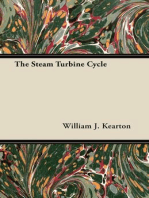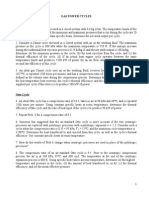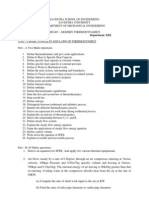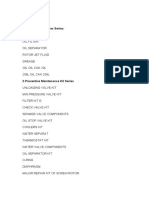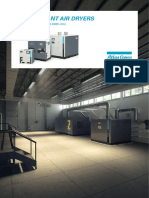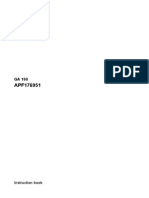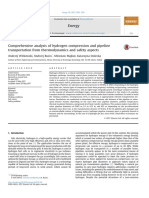Questions - Otto & Diesel Cycle
Questions - Otto & Diesel Cycle
Uploaded by
talkeennomaniCopyright:
Available Formats
Questions - Otto & Diesel Cycle
Questions - Otto & Diesel Cycle
Uploaded by
talkeennomaniOriginal Title
Copyright
Available Formats
Share this document
Did you find this document useful?
Is this content inappropriate?
Copyright:
Available Formats
Questions - Otto & Diesel Cycle
Questions - Otto & Diesel Cycle
Uploaded by
talkeennomaniCopyright:
Available Formats
Question: Otto and Diesel cycle
1. Calculate the ideal air standard cycle efficiency based on the Otto cycle for a gas engine with a cylinder
bore of 50 mm, a stroke of 75 mm, and a clearance volume of 21.3 cm3.
2. An idealized air-standard diesel cycle has a compression ratio of 15. The energy input is idealized as a
heat transfer of 700 Btu/lbm. The inlet conditions are 70 oF at 1 atm. Find the pressure and temperature
at the end of each process in the cycle and determine the cycle efficiency.
3. An oil engine takes in air at 1.01 bar, 20 oC, and the maximum cycle pressure is 69 bar. The compressor
ratio is 18:1. Calculate the air standard thermal efficiency based on the dual-combustion cycle. Assume
that the heat added at constant volume is equal to the heat added at constant pressure.
4. A four-stroke Otto cycle has a crankshaft speed of 2000 rpm, a compression ratio of 8, and a
displacement volume of 1.5 liters. At the start of compression, the air is at 293 K, 0.1013 MPa. The
peak cycle temperature is equal to the 2000 K source temperature. The compression and expansion
processes are each reversible and adiabatic. Assuming constant specific heat, make a complete thermal
analysis of the engine. Find the energy transfer per unit mass for each process in the cycle.
5. At the start of the compression process in a Diesel-cycle engine, the air is at 530 R, 14.7 psia. The
compression ratio is 16. The peak cycle temperature is equal to the 4000 R source temperature. The
adiabatic compression and expansion processes are reversible. Even though high temperatures are
involved, assume that specific heats are constants at their low-temperature values. Find the energy
transfer per unit mass for each process in the cycle.
6. A diesel engine has a compression ratio of 15 and heat addition at constant pressure takes place at 6%
of stroke. Find the air standard efficiency of the engine. Take γ for air as 1.4.
7. The stroke and cylinder diameter of a compression ignition engine are 250 mm and 150 mm
respectively. If the clearance volume is 0.0004 m3 and fuel injection takes place at constant pressure
for 5 per cent of the stroke determine the efficiency of the engine. Assume the engine working on the
diesel cycle.
8. Calculate the percentage loss in the ideal efficiency of a diesel engine with compression ratio 14 if the
fuel cut-off is delayed from 5% to 8%.
9. The mean effective pressure of a Diesel cycle is 7.5 bar and compression ratio is 12.5. Find the
percentage cut-off of the cycle if its initial pressure is 1 bar.
10. An engine with 200 mm cylinder diameter and 300 mm stroke works on theoretical Diesel cycle. The
initial pressure and temperature of air used are 1 bar and 27°C. The cut-off is 8% of the stroke.
Determine: (i) Pressures and temperatures at all salient points, (ii) Theoretical air standard efficiency,
(iii) Mean effective pressure, (iv) Power of the engine if the working cycles per minute are 380. Assume
that compression ratio is 15 and working fluid is air. Consider all conditions to be ideal.
You might also like
- Jih 20 24 英文說明書 標準機+護罩 (Auto)Document28 pagesJih 20 24 英文說明書 標準機+護罩 (Auto)Michał JabłońskiNo ratings yet
- Ejercicios Motores.Document10 pagesEjercicios Motores.Daniel Armas100% (1)
- ICE All ExercisesDocument10 pagesICE All ExercisesB Ninh100% (1)
- Assignment - 2 TE-1-1Document1 pageAssignment - 2 TE-1-1Lalith SunkojuNo ratings yet
- Q-1 (Otto, Diesel and Dual Combustion)Document2 pagesQ-1 (Otto, Diesel and Dual Combustion)jhigs amfufuNo ratings yet
- Me8493 Te Rejinpaul Iq Am19 PDFDocument2 pagesMe8493 Te Rejinpaul Iq Am19 PDFAngelinNo ratings yet
- Air Standard Diesel CyclesDocument1 pageAir Standard Diesel Cyclespkpavankumar8715No ratings yet
- Assgnment 1Document3 pagesAssgnment 1GaneshGaniNo ratings yet
- Gas Power Cycle - AssignmentDocument3 pagesGas Power Cycle - AssignmentXerox WorldNo ratings yet
- Thermal EnggDocument9 pagesThermal Enggmadhume01No ratings yet
- Adv IC Engines Assignment No 2.Document3 pagesAdv IC Engines Assignment No 2.Madhupriya KalahastiNo ratings yet
- Assignment2 - 110006 - Elements of Mechenical EngineeringDocument6 pagesAssignment2 - 110006 - Elements of Mechenical EngineeringSaniya Jumani0% (1)
- Cycle Q'sDocument3 pagesCycle Q'sloolmoom100% (1)
- Thermal Engineering Question BankDocument33 pagesThermal Engineering Question BankmechgokulNo ratings yet
- Sheet 2 - Air Stanard CycleDocument5 pagesSheet 2 - Air Stanard CycleFarah SayedNo ratings yet
- Thermal Engineering-Question BankDocument32 pagesThermal Engineering-Question BankAlfred Franklin VNo ratings yet
- 16marks QueusionDocument19 pages16marks QueusionprasanthprpNo ratings yet
- Srinivasan Engineering College, Perambalur-621212: Question Bank Unit I Gas Power CyclesDocument18 pagesSrinivasan Engineering College, Perambalur-621212: Question Bank Unit I Gas Power CyclesagrikarthiNo ratings yet
- Tutorial Gas Turbine CyclesDocument6 pagesTutorial Gas Turbine CyclesPranav MishraNo ratings yet
- Heat Engine Question-1Document31 pagesHeat Engine Question-1Mohammed youssifNo ratings yet
- 7.1.prob - Sheet Gas Power CyclesDocument3 pages7.1.prob - Sheet Gas Power CyclesAnonymous mXicTi8hB0% (1)
- Unit - 1 Air Standard Cycle - Numericals QuestionsDocument3 pagesUnit - 1 Air Standard Cycle - Numericals Questions1ds22me007No ratings yet
- ICE Assignment 15032017 035808AMDocument5 pagesICE Assignment 15032017 035808AMGerlan Madrid MingoNo ratings yet
- Sheet 5 ICEDocument2 pagesSheet 5 ICEAtheer SatNo ratings yet
- Air Standard Otto CyclesDocument1 pageAir Standard Otto Cyclespkpavankumar8715No ratings yet
- ICE RevisionDocument4 pagesICE RevisionjehadyamNo ratings yet
- ICE Assignment 8AMDocument5 pagesICE Assignment 8AMRushabh Patel0% (1)
- Thermal Univ PDFDocument8 pagesThermal Univ PDFNithin Mathew EyyalilNo ratings yet
- IC Engines (Asst 2)Document2 pagesIC Engines (Asst 2)narasimha raoNo ratings yet
- ATD Module3 Practice ProblemsDocument3 pagesATD Module3 Practice ProblemsKrishna KumarNo ratings yet
- Assignment and Its Solution - Airstandardcycle and VapourcycleDocument24 pagesAssignment and Its Solution - Airstandardcycle and VapourcycleMatthias100% (1)
- A. Otto Cycle (Gasoline Engine)Document22 pagesA. Otto Cycle (Gasoline Engine)John Manuel BautistaNo ratings yet
- COMBSUTION SHEET 7Document2 pagesCOMBSUTION SHEET 7Mirna RaafatNo ratings yet
- Magtulis, Kate Anne M. Problem Set #2 Che 124 - Chemical Engineering Thermodynamics 2 July 22, 2015Document7 pagesMagtulis, Kate Anne M. Problem Set #2 Che 124 - Chemical Engineering Thermodynamics 2 July 22, 2015Lucienne IrianaNo ratings yet
- Chapter 6 - Gas Power Cycles - Updated - 2023Document2 pagesChapter 6 - Gas Power Cycles - Updated - 2023Yonas BelaynehNo ratings yet
- ETD AssignmentDocument1 pageETD AssignmentbipincitNo ratings yet
- Assignment VIIIDocument3 pagesAssignment VIIINathiNo ratings yet
- Thermal Univ QBDocument15 pagesThermal Univ QBrajapratyNo ratings yet
- Report on Air Standard CyclesDocument1 pageReport on Air Standard CyclesZee SanNo ratings yet
- Local Media1133470422700059155Document6 pagesLocal Media1133470422700059155Billy JhunNo ratings yet
- Mathematical Problem On Thermo CycleDocument5 pagesMathematical Problem On Thermo CycleMaherNo ratings yet
- Steam EnginesDocument6 pagesSteam Engineschat2adiNo ratings yet
- 4 - Gas Power CycleDocument4 pages4 - Gas Power CycleMohamed MohamedNo ratings yet
- Thermal Questions KonguDocument9 pagesThermal Questions Konguabu19870% (1)
- Applied Thermal Engineering - II (MEC 316) Unit - 2 Gas Turbines Tutorial SheetDocument4 pagesApplied Thermal Engineering - II (MEC 316) Unit - 2 Gas Turbines Tutorial SheetShashi Kant KhalkhoNo ratings yet
- Testo Esami 2021 - 2023Document27 pagesTesto Esami 2021 - 2023tzsq5scsfxNo ratings yet
- Unit I: Gas Power CyclesDocument78 pagesUnit I: Gas Power CyclesBalaji DsNo ratings yet
- Tutorial AssignmentDocument5 pagesTutorial AssignmentAnup ChauhanNo ratings yet
- ME6404 Thermal EngineeringDocument21 pagesME6404 Thermal EngineeringAnonymous mRBbdopMKfNo ratings yet
- Ques - Eee MTDocument12 pagesQues - Eee MTKumaran PalaniNo ratings yet
- P R o B L e M S o F P R A C T I C e S O F B A S I C A N D A P P L I e D T H e R M o D y N A M I C S I - C - E N G I N eDocument21 pagesP R o B L e M S o F P R A C T I C e S O F B A S I C A N D A P P L I e D T H e R M o D y N A M I C S I - C - E N G I N eAnonymous ncBe0B9bNo ratings yet
- Tutorial-3 Updated 6-4-2015Document7 pagesTutorial-3 Updated 6-4-2015Sai Bala100% (1)
- IC Engine Parameters QuestionsDocument2 pagesIC Engine Parameters QuestionsMohamed MounirNo ratings yet
- Review Problems: Module 1 - CompressorsDocument5 pagesReview Problems: Module 1 - CompressorsJustine Somentac0% (1)
- Gas Power Cycles Assignment QuestionsDocument1 pageGas Power Cycles Assignment QuestionsÇãłl Mê MęlkãNo ratings yet
- Fluke 810 Vibration Tester: Technical DataDocument4 pagesFluke 810 Vibration Tester: Technical DatasamiNo ratings yet
- 13978X-01 - 02 - Alarm and Trip MatrixDocument8 pages13978X-01 - 02 - Alarm and Trip Matrixsiddiqui aadilNo ratings yet
- IGV IMECE 0821 2 Column Final3Document7 pagesIGV IMECE 0821 2 Column Final3tasneemengsolNo ratings yet
- Compressor Heat Pump Model Based On Refrigerant enDocument16 pagesCompressor Heat Pump Model Based On Refrigerant enOussema SKNo ratings yet
- Technological Innovations in Heat Pump Systems: Renato M. LazzarinDocument27 pagesTechnological Innovations in Heat Pump Systems: Renato M. LazzarinAdila AnbreenNo ratings yet
- AirVini Screw CatalogueDocument15 pagesAirVini Screw CatalogueMontasserNo ratings yet
- Ram Kumar Rig MechDocument3 pagesRam Kumar Rig MechDIJUNo ratings yet
- JetCat PRO Engines 2022Document9 pagesJetCat PRO Engines 2022Yücel Orkut AktaşNo ratings yet
- EthedcoDocument98 pagesEthedcosherifelbayoumy266No ratings yet
- Annexure I Mechanical EngineeringDocument2 pagesAnnexure I Mechanical EngineeringNaga Sai MuthyalaNo ratings yet
- Air Compress Parts Product List From ONWISEDocument3 pagesAir Compress Parts Product List From ONWISEkasim leeNo ratings yet
- Westinghouse AC CatalogueDocument80 pagesWestinghouse AC Cataloguejassim mohammed100% (2)
- 4MW-28-40 Non-Lubrication Air Compressor QUOTATIONDocument2 pages4MW-28-40 Non-Lubrication Air Compressor QUOTATIONJose Hurtado OjedaNo ratings yet
- Refrigeration & Air Conditioning: ME 170: Fundamentals of Mechanical Engineering (Model Lab)Document52 pagesRefrigeration & Air Conditioning: ME 170: Fundamentals of Mechanical Engineering (Model Lab)Umair MueedNo ratings yet
- MET Building ChillersDocument12 pagesMET Building Chillersoth369No ratings yet
- English: 7425MUM009 Rev00 - GBDocument17 pagesEnglish: 7425MUM009 Rev00 - GBMaciekLembrykNo ratings yet
- Dry Vacuum Pump Cobra Busch enDocument2 pagesDry Vacuum Pump Cobra Busch enJessica ChandlerNo ratings yet
- FD CatalogueDocument16 pagesFD Cataloguevirtech1No ratings yet
- For Screw Compressor Oil Stop Valves Types 0SV-NG and OSV-NIDocument2 pagesFor Screw Compressor Oil Stop Valves Types 0SV-NG and OSV-NIboobalan_shriNo ratings yet
- TDS - Total - Dacnis 68 - 25o - 202008 - enDocument1 pageTDS - Total - Dacnis 68 - 25o - 202008 - enMuhammmad Naqi RazaNo ratings yet
- Apf176951 enDocument126 pagesApf176951 enRebeca SantosNo ratings yet
- Ed 04 (EN)Document32 pagesEd 04 (EN)King MaxNo ratings yet
- Project Report WDM2Document44 pagesProject Report WDM2Vaibhav Jain67% (3)
- SOLEST BrochureDocument6 pagesSOLEST BrochurekuanyiNo ratings yet
- PSME Code TermsDocument11 pagesPSME Code TermsHazel BayaniNo ratings yet
- ENG The Air and Brake Feed SystemDocument144 pagesENG The Air and Brake Feed SystemFares Masry100% (4)
- Comprehensive Analysis of Hydrogen Compression and Pipeline Transportation From Thermodynamics and Safety AsepectsDocument11 pagesComprehensive Analysis of Hydrogen Compression and Pipeline Transportation From Thermodynamics and Safety Asepects기계공학과/김수빈No ratings yet
- PG 186-100 (ELGi)Document4 pagesPG 186-100 (ELGi)Ismail AliNo ratings yet
- ch05 PDFDocument8 pagesch05 PDFAkash ThummarNo ratings yet



